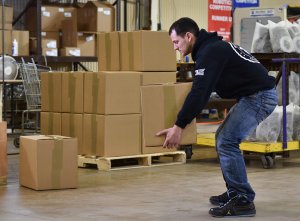Q & A From Material Handling Webinar
01/30/2012

by Christy Lotz, CPE
 Thanks to those of you who attended our Ergonomics for Manual Material Handling webinar last Friday. There were some questions that we did not have time to get to during the event, but we have posted our answers below. If we happened to miss one of your questions, feel free to write in a comment and we will get it answered.
Thanks to those of you who attended our Ergonomics for Manual Material Handling webinar last Friday. There were some questions that we did not have time to get to during the event, but we have posted our answers below. If we happened to miss one of your questions, feel free to write in a comment and we will get it answered.
What were the 3 ranges of the Lifting Index - Red, Yellow, and Green?
Green represents a lifting index under 1.0
Yellow represents a lifting index between 1.0 and 3.0
Red represents a lifting index greater than 3.0
We have a process in which the operator does not lift the load but needs to twist the back to move it.
The NIOSH Lifting Equation was designed for lifting/lowering tasks and is focused on back burden. However, there are a number of assessment tools available that focus on multiple body parts, and risk factors such as Posture, Force, Frequency and Duration. Using an assessment tool like Humantech’s BRIEF™ (Baseline Risk Identification of Ergonomic Factors) Survey or REBA (Rapid Entire Body Assessment) would be the best option for the scenario you described.
Please explain the time factor which appears to increase the load limit for NIOSH.
The two “time” factors you may be referring to, are the frequency and duration. Frequency refers to the number of lifts per minute (minimum = 0.2 lifts/minute, maximum = 15 lifts/minute). Duration refers to the amount of total time spent lifting (< 1 hour, < 2 hours, < 8 hours). For instance, if you lift a box 480 times per 8 hour shift, the frequency would be 1 lift per minute, and the duration would be 8 hours.
At our workplace, like many others, we have an aging workforce, which of course can present problems and more ergonomic-related injuries. Do either of these tools account for an “age” factor?
This is definitely something that should be considered. Currently, the equation shown does not account for the aging population, and you’re right that it may make an impact and should be considered. There are a lot of factors that we have to be cognizant about when faced with an aging population, such as strength, vision, hearing, and cardiovascular demands. Humantech will be addressing a few of these concerns and recommendations in a webinar in May.
If you are using a cart with only one set of casters that swivel, and the other two casters do not swivel, where should the casters that swivel be located on the cart - front or rear?
Front wheels should swivel for pulled carts, and back wheels should swivel for pushed carts.
Does the NIOSH lifting equation rely on a certain coefficient of friction between the person lifting and the floor?
The NIOSH Lifting Equation does not take into consideration the standing surface. It assumes a “dry” surface. Therefore, a slippery surface would increase risk/burden from an ergonomic and safety perspective and you would be underestimating the risk to the operator.
Why does the HT LiftCalc app only have 15 degree increments for angle of assymetry?
During the webinar, we mentioned that Humantech has a NIOSH Lifting Equation application (HT NIOSH Lift Calculator). In order to make it easier to use, we had the angle toggle increase by 15 degree increments (0 to 135 degrees). Changing the angle by one degree does not have a significant impact, if any, on the overall score, so it was decided that it was determined that this would be easier for users.
What is the best tool to analyze a no-lift process?
There are a number of free assessment tools available that can be used to analyze all body parts with exposure to tasks that do not just include lifting. For instance, REBA, WISHA (Washington State Checklist for Work-Related Musculoskeletal Disorders), RULA (Rapid Upper Limb Assessment), Job Strain Index etc.






